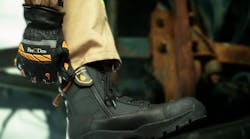At that time, the prevailing attitude was, "We fight all fires. Deaths are simply acceptable in the nature of things "
I know of no such letter as I suggested having been written. However, the atmosphere is changing. Across the country chiefs are questioning the tradition of automatically attacking any fire in any dump, because, "That is what we do"
If you would like the text of the article just ask for it, free, at [email protected]
When the management staff of AEC Headquarters at Germantown, MD moved all the record storage from the sprinklered basement space built for the purpose, to an unsprinklered space to make room for the computers, the building manager was angry. He had not been consulted.
He resisted recommendations to sprinkler the new vault. I got him to write to the fire department recommending no firefighting in the vault. As he cooled down and recognized the situation he would be in if there were a fire, he came to his senses and installed the sprinklers at a cost of about $3000!
Spanish Lesson
The word BOMBERO in Spanish does not mean a bomb. It means firefighter.
All units with Spanish speaking populations should be taught enough Spanish to understand what Spanish speakers at a fire are saying.
This is not a new idea. Forty years ago on a visit to New York City, I walked into the quarters of 24 Truck. They were out but on the blackboard I noticed (as I recall) "donde este el fuego?". " Where is the Fire?"
When my friend Jack Cashman fell down an airshaft the occupants came out screaming about a "bombero". The brothers knew it meant a firefighter in trouble not a bomb. Would your troops know?
Dangerous orders
For some time now, I have offered by reply E mail the story of "Disaster on Broadway" (To get a copy send a signed request to [email protected] Imaginative incomprehensible address are not enough)
Two of the comments I received are of particular interest.
The article should be used in command courses to start discussion on the subject of what a junior does when given an order which will place his/her unit in a very dangerous position without any justified benefit.
A retired BC from FDNY wrote of his experience when as a Lt. he mustered up his courage and refused to take his company into a store where it was apparent that the ceiling was about to fall. In a few moments the ceiling collapsed. He started to advance into the store. He was told, "Take your company out of there." The chief, shocked at the near disaster, could not say, "Gee thanks for seeing that hazard".
The lesson the Lt. applied when he was a chief is that the IC does not know it all and there are possibly people on the fire ground who know something which would be very useful in setting a course of action. The IC should be flexible enough to obtain and use this information.
I can recall a personal experience. In 1947 I was the Assistant Fire Protection Manager of the Fifth Naval District at Norfolk, VA and the person believe to be most knowledgeable about ship fires.
There was a British Aircraft Carrier in the Navy Yard at Portsmouth, VA with an inexplicable smoke condition in a lower deck compartment. Navy Yard Fire Chief Waverly Sykes, a most competent fire officer and my good friend, had asked that I come over and see if I could help.
When I arrived at the ship, personnel in SCBA had been searching the smoky compartment for some time with no results. I joined the group with the British Admiral, the Commandant of the Yard and Chief Sykes. As I was being clued in, Chief Sykes noticed a British seaman clutching his cap and looking as if he had something to say, but was unwilling to approach the brass.
Sykes called him over and asked him if he knew something. "There is a lazarette door in that compartment and we were stowing ammunition mats in the compartment and some of the blokes were smoking."
A "lazarette door" is a half-high door. Ammunition mats are heavy mats made of manila rope, used to cushion the impact of shells being placed on a deck. If you have ever seen beer barrels being unloaded you may have noticed the heavy mats used to cushion the impact of the barrels.
All the firefighters looking for a door in the smoky compartment had felt along the bulkheads while standing. They were sent back down with orders to search on hands and knees. The Lazarette door was found and the smoldering mats extinguished.
I am most grateful to those who have emailed an appreciation of the work Maurine and I have done to save firefighters lives. I will put them together to read to her as her memory fails.





